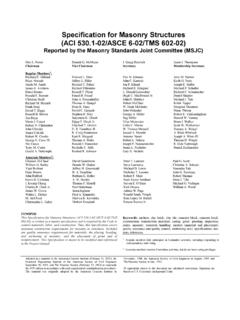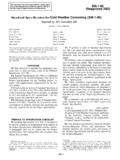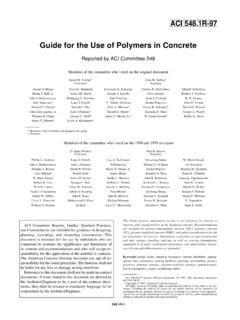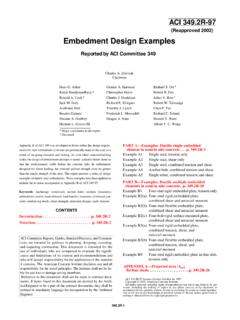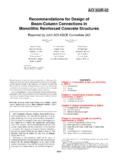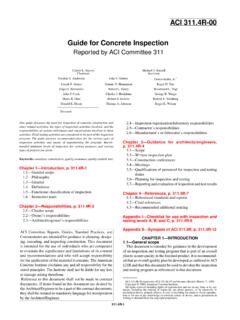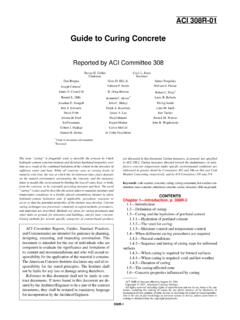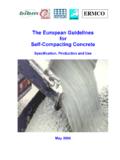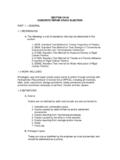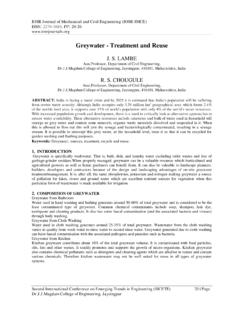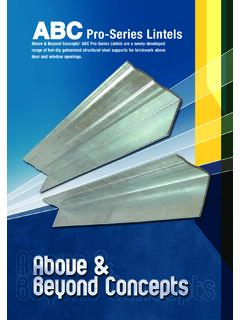Transcription of 225R-99 Guide to the Selection and Use of …
1 ACI 225R-99 became effective September 7, 1999, American Concrete rights reserved including rights of reproduction and use in any form or by anymeans, including the making of copies by any photo process, or by electronic ormechanical device, printed, written, or oral, or recording for sound or visual reproduc-tion or for use in any knowledge or retrieval system or device, unless permission inwriting is obtained from the copyright proprietors. ACI Committee Reports, Guides, Standard Practices, andCommentaries are intended for guidance in planning, de-signing, executing, and inspecting construction. The Docu-ment is intended for the use of individuals who arecompetent to evaluate the significance and limitationsof its content and recommendations and who will acceptresponsibility for the application of the material it con-tains.
2 The American Concrete Institute disclaims any andall responsibility for the stated principles. The Institute shallnot be liable for any loss or damage arising to the Document shall not be made in contractdocuments. If items found in this Document are desiredby the Architect/Engineer to be a part of the contract doc-uments, they shall be restated in mandatory language forincorporation by the Architect/Engineer. 225R-1 Reported by ACI Committee 225 Claude BedardMichael S. HammerColin L. LoboGlen E. BollinEugene D. HillKenneth MackenzieMichael M. ChehabR. Doug HootonBryant MatherJames R. Clifton*Kenneth G. KazanisWalter J. McCoyChristopher CrouchPaul KliegerLeo M. Meyer, A. DayeSteven H. KosmatkaJames S. PierceGeorge R. DeweyJim KuykendallSandor PopovicsRichard D.
3 GaynorBryce P. Simons*DeceasedBecause cement is the most active component of concrete and usually hasthe greatest unit cost, its Selection and proper use is important in obtainingthe balance of properties and cost desired for a particular concrete mix-ture. Selection should take into account the properties of the availablecements and the performance required of the concrete. This report summa-rizes information about the composition and availability of commercialhydraulic cements, and factors affecting their performance in a discussion of the types of cements and a brief review of cementchemistry, the influences of admixtures (both chemical and mineral) andthe environment on cement performance are discussed.
4 The largest part ofthis report covers the influence of cement on the properties of storage and delivery, and the sampling and testing of hydrauliccements for conformance to specifications, are reviewed briefly. This report will help users recognize when a readily available, general-purpose (ASTM C 150 Type I) cement will perform satisfactorily, or whenconditions require Selection of a cement that meets some additionalrequirements. It will also aid cement users by providing general informa-tion on the effects of cements on the properties of concrete. Some chemicaland physical characteristics of cement affect certain properties of concretein important ways. For other properties of concrete, the amount of cementis more important than its characteristics.
5 This report is not a treatise on cement chemistry or concrete. For thosewho need to know more, this report provides many references to the techni-cal literature, including ACI to the Selection and Use of Hydraulic CementsACI 225R-99 Keywords: admixtures; blended cements; calcium-aluminate cements;cements; cement storage; chemical analysis; concretes; hydraulic cements;mineral admixtures; physical properties; portland cements; sampling; Selection ; tests. CONTENTS Chapter 1 Introduction, p. The need for a rational approach to selecting Purpose of the reportChapter 2 Cement types and av ailability, p. Portland and blended hydraulic Special-purpose cementsChapter 3 Cement chemistry, p. Portland cements Blended hydraulic cements Shrinkage-compensating expansive cements Calcium-aluminate cementsChapter 4 Influence of chemical and mineral admixtures and slag on the performance of cements, p.
6 Air-entraining admixtures Chemical admixtures Mineral admixtures Ground granulated blast-furnace slags Gregory S. BargerChairman 225R-2 ACI COMMITTEE REPORTC hapter 5 Influence of environmental conditions on the behavior of cements, p. 11 Chapter 6 Influence of cement on properties of concrete, p. Thermal cracking Placeability Strength Volume stability Elastic properties Creep Permeability Corrosion of embedded steel Resistance to freezing and thawing Resistance to chemical attack Resistance to high temperatures Cement-aggregate reactions Color Chapter 7 Cement storage and delivery, p. 21 Chapter 8 Sampling and testing of hydraulic cements for conformance to specifications, p. The cement mill test Sealed Cement Quality managementChapter 9 References, p.
7 Recommended references Cited references Appendix Calcium-aluminate cements, p. 29 CHAPTER 1 INTRODUCTION The need for a rational approach to selecting cements Cement paste is the binder in concrete or mortar that holdsthe fine aggregate, coarse aggregate, or other constituents to-gether in a hardened mass. The term hydraulic is associatedwith the word cement in this document to point out to theconsumer that the basic mechanism by which the hardeningof the concrete or mortar takes place is the reaction of the ce-ment material with water. The word hydraulic also differen-tiates this type of cement from binder systems that are basedon other hardening properties of concrete depend on the quantities andqualities of its constituents.
8 Because cement is the most activecomponent of concrete and usually has the greatest unit cost,its Selection and proper use are important in obtaining mosteconomically the balance of properties desired for a particularconcrete mixture. Most cements will provide adequate levelsof strength and durability for general use. Some providehigher levels of certain properties than are needed in specificapplications. For some applications, such as those requiringincreased resistance to sulfate attack, reduced heat evolution,or use with aggregates susceptible to alkali-aggregate reac-tion, special requirements should be imposed in the purchasespecifications. While failure to impose these requirementsmay have serious consequences, imposing these requirementsunnecessarily is not only uneconomical but may degrade oth-er more important performance characteristics.
9 For example,moderate sulfate resistance may be specified for certain plant-manufactured structural elements that require strength gain inthe production process. Because the compositional variationsthat impart sulfate resistance tend to reduce the rate ofstrength gain, some compromise must be goal of the specifier is to provide specifications thatwill ensure that the proper amounts and types of cement areobtained to meet the structural and durability require-ments no more, no less. Due to gaps in our knowledge, thisgoal is seldom, if ever, fully achieved; economies, however,can often be obtained with little or no decrease in perfor-mance in service, if specifications are aimed at this goal. For a long time, there have been virtually no economic pen-alties to discourage users and others from overspecifying ce-ment characteristics.
10 For example, even though a fullysatisfactory ASTM C 150 Type I cement has been available,users have often chosen to specify an ASTM C 150 Type IIcement or a low-alkali cement on the basis that it could do noharm and its special characteristics might be beneficial. Theyhave not had to worry about possible shortages of supply orincreased cost. The effects of increased attention to pollutionabatement and energy conservation, however, are changingthe availability and comparative costs of all types of brings about a need for greater understanding of factorsaffecting cement performance than was previously necessary. It is usually satisfactory and advisable to use a general-pur-pose cement that is readily obtainable locally.

